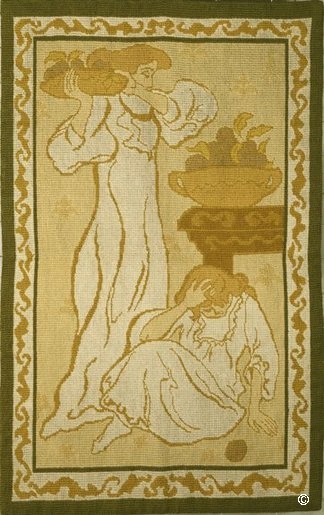Illustration: Paul Ranson. Alpha and Omega tapestry, 1895.
The Frenchman Paul Ranson was both a fine and decorative artist who produced work in a number of fields including textiles, and more specifically that of tapestry. His work has been closely associated with the Nabis of which he was an enthusiastic member. The Nabis group was a pseudo-religious gathering of some of the most forward thinking fine artists of 1890s Paris. They including both full and partial members and ranged from Ranson himself to individual artists such Pierre Bonnard, Georges Lacombe, Aristide Malliol, Eduard Vuillard and the Hungarian Jozsef Rippl-Ronai. They dabbled with religious imagery and esoteric fashions of the day and included ideas on theosophy and philosophy amongst other subjects. However, it is sometimes distracting to concentrate too much on the Nabis and their philosophical and religious manifesto, and not enough time on the practicalities of some of the decorative work they produced during this period.
Illustration: Paul Ranson. Two nudes, 1890.
Ranson produced a number of tapestries, most of which differed very little compositionally, certainly in a narrative sense, from his fine art work. Interestingly he was amongst other things, a trained engraver and this perhaps gives some indication at to why his tapestry work gives the distinct impression of being akin to marquetry rather than a strictly woven fabric, marquetry was also a skill in which Ranson produced decorative work.
One of the reasons that Ranson produced tapestry work in the first place was the Nabis partial affiliation with the tenets of the English Arts & Crafts movement. Partial in the respect that the members wished to bring every day aspects of life within the sphere of fine art and vice versa, but did not necessarily wish to include the whole range of philosophy that was so much a part of the English movement. However, it did mean that artists such as Ranson were much more willing to open up creatively and work in a range of crafts and disciplines that could only add positively to their experience. Some of the tapestries designed by Ranson were woven by his wife which adds to the initial philosophy of the Arts & Crafts movement and its idealisation of both hand production and low key domestic participation in the crafts.
Illustration: Paul Ranson. Women in White tapestry, 1895.
Ranson himself, while working through his religious and esoteric symbolism which appeared on a number of canvases and tapestries, was influenced by Japanese prints in particular and with that the creative graphic experience which was such a large part of the media world of 1890s France. The lack of dimensions and the often sinuous lines in Ranson's work give a good indication that the artist was aware of trends and initiatives that were beginning to influence art, design and decoration across many disiplines and mediums in France.
Although not all of the illustrations in this article are concerned with Ranson's tapestry work, the fine art pieces do give the same feeling towards an aspect of Ranson's work that appeared both contemporary and indicative of the changes that were taking place across Europe, not just France. While there is every indication that Ranson, along with others within this particular era of European decorative and artistic history, were heavily influenced by Japanese art and print work, it would be a mistake to see this as an ending in itself. Where Ranson and others were taking this Japanese inspiration was to a completely different place creatively from the initial exposure. As can be seen in Ranson's Alpha and Omega tapestry piece, a whole range of complex initiatives have already been set in place, most deriving from the common European experience whether that be culturally, spiritually or creatively.
Illustration: Paul Ranson. Two tapestries, c1900.
All creative work is produced not in a vacuum, but in a rich spawning ground where initial inspiration can sometimes be both intense and emulative. However, truly creative initiatives quickly overcome this period and a uniquely individual approach will soon follow. This is true in the case of Ranson, the Nabis and the phenomenon of Japanese inspiration in general. Ranson's creative tapestries add to the already rich compositional narrative of the discipline that could be found amongst tapestry artists and designers across Europe during this changeover period from the nineteenth to the twentieth centuries.
Although the relationship between Ranson, the Nabis group and fine art is a complex one, this article is only concerned with the artists tapestry output. Although it is indeed difficult to separate the ideals and philosophy of an artist from his creative work, tapestry by its very nature is much more about decoration and the practicalities of design and therefore the Nabis philosophy has been laid aside for this particular need.
Illustration: Paul Ranson. Digitales, 1899.
Apple Tree with Red Fruit, c.1902 Art Poster Print by Paul Ranson, 32x24
Paul Elie Ranson: Du symbolisme a l'art nouveau (French Edition)
Oil Painting Reproductions, Art Reproductions, Paul Ranson, The Clearing Edge of the Wood, 30" x 46" (76cm x 117cm), 100% Hand Painted Oil On Canvas Replica Masterpiece
Paul Ranson, 18611909: Catalogue Raisonne, Japonisme, Symbolism
Oil Painting Reproductions, Art Reproductions, Paul Ranson, Japanese Style Landscape, 25.6" x 32" (65cm x 81cm), 100% Hand Painted Oil On Canvas Replica Masterpiece
Les Nabis. Taurus Number 11, May-June 1969
Christ and Buddha, circa 1890-1892 Artists Giclee Poster Print by Paul Ranson, 12x16
The Nabis: Bonnard, Vuillard and Their Circle
The Nabis (Art of Century)
Bonnard and the Nabis (Temporis)
Gauguin and the Nabis: Prophets of Modernism
Nabis (Schools & movements of painting)
The Nabis and the Parisian Avant-Garde





